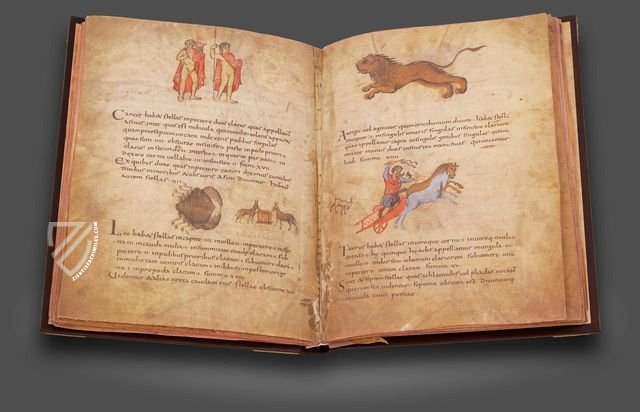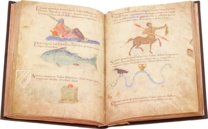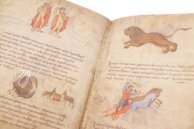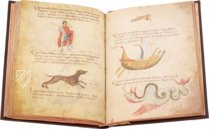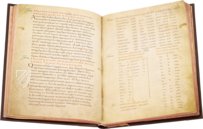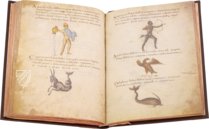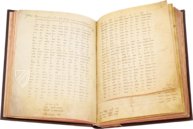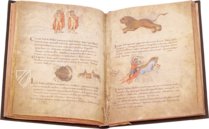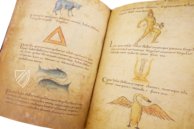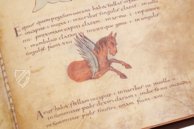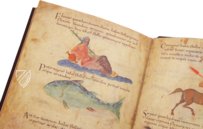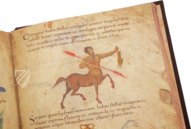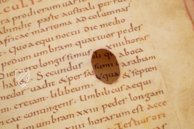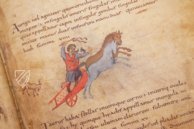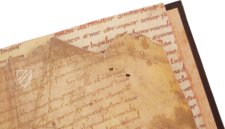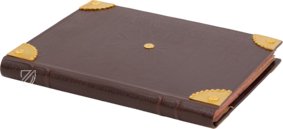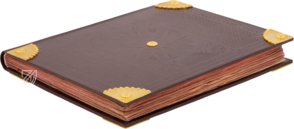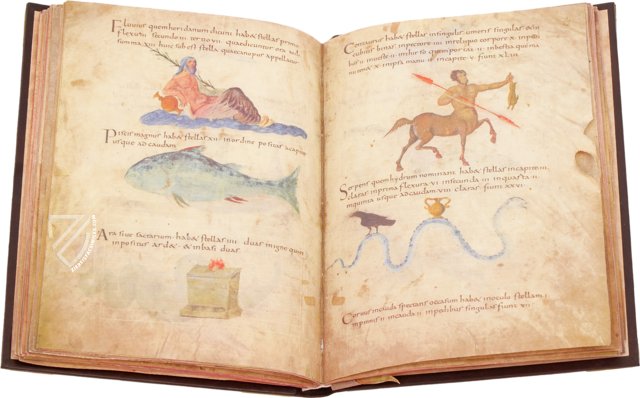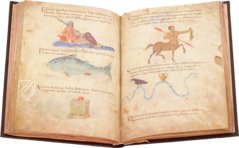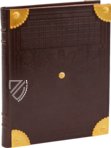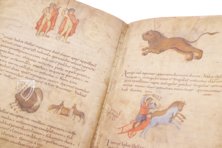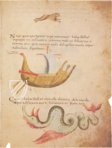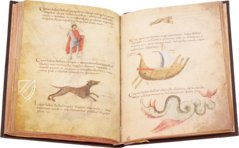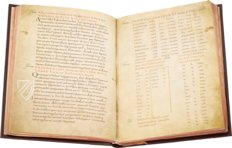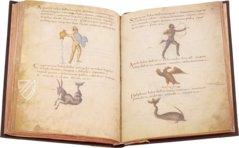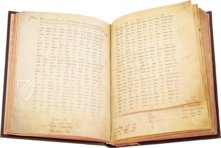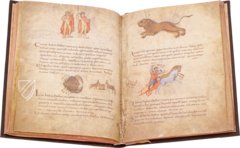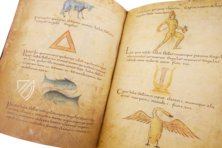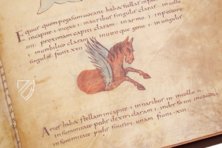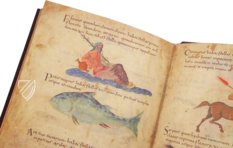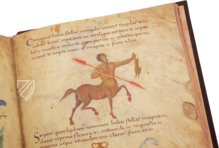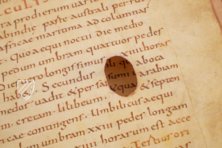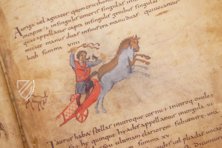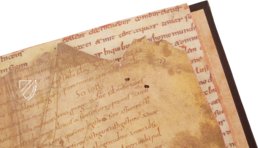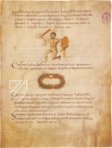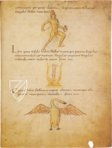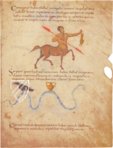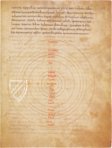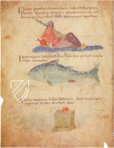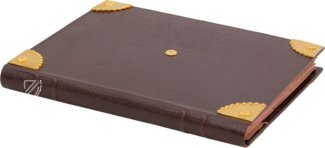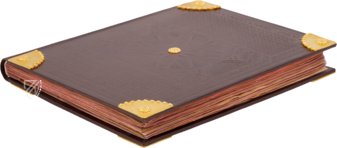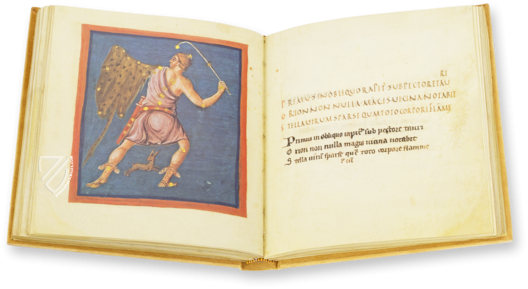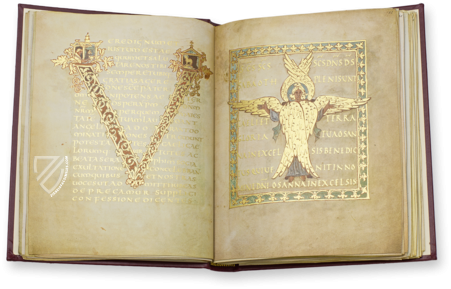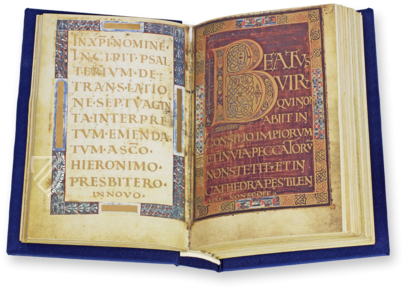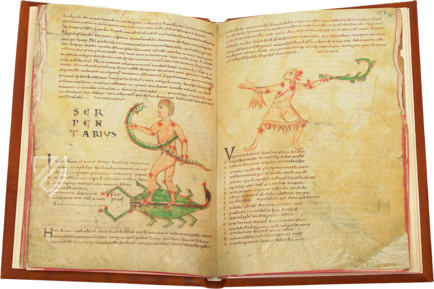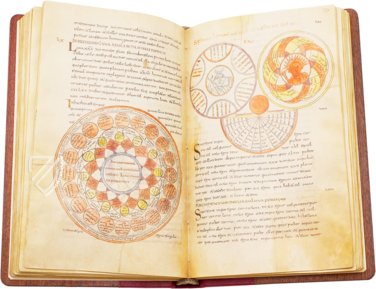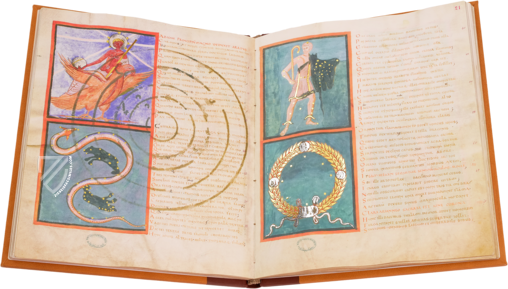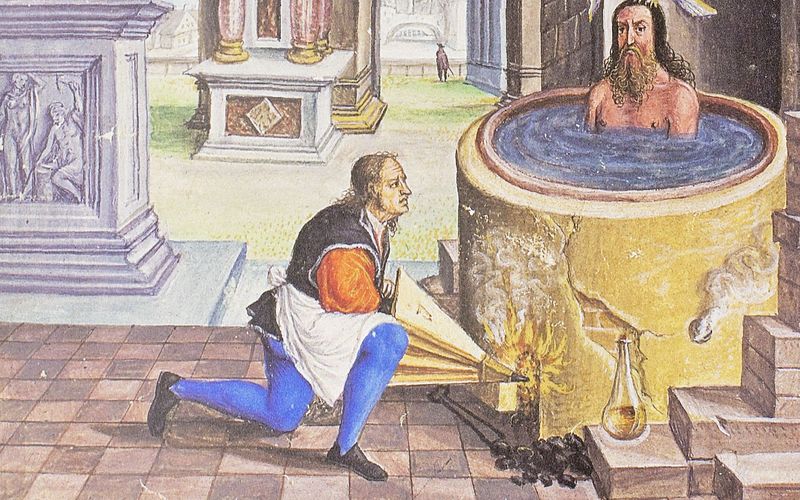Metz Codex
(1,000€ - 3,000€)
The famous Metz Codex is an astronomical manuscript from the early 9th century. The codex was made at the behest of Drogo, Bishop of Metz and one of the sons of Charlemagne. Drawing on a manuscript from late antiquity as a template, the Metz Codex possesses an astronomical calendar for the precise calculation of church feasts or the like. The gorgeously colored figures, which illustrates the pages, are particularly interesting: representations of ancient zodiac symbols. The manuscript is a historical source of the first rank and offers a magnificent glimpse into the mysteries of 9th century astronomy.
Metz Codex
The famous Metz Codex is an astronomical manuscript from the early 9th century. The codex was made at the behest of Drogo, Bishop of Metz and one of the sons of Charlemagne. Drawing on a manuscript from late antiquity as a template the Metz Codex possesses an astronomical calendar for the precise calculation of church feasts or the like. The gorgeously colored figures, which illustrates the pages, are particularly interesting: representations of ancient zodiac symbols. The manuscript is a historical source of the first rank and offers a magnificent glimpse into the mysteries of 9th century astronomy.
A Carolingian Zodiac Cycle
This precious manuscript from the Carolingian period is stored in the Spanish National Library. The fascinating 9th century work of astronomy unfolds on 152 pages measuring 31.5 x 25 cm. Drawing on ancient manuscripts, the astronomical handbook contains expositions on cosmology and chronology according to the constellations of Aratus. The astronomical calendar made seemingly precise calculations of the church feasts possible, but also had a religious and political dimension.
The Famous Patron
The patron of this astronomic treatise was Drogo, Bishop of Metz. Drogo (801–855) was a son of Charlemagne and half-brother to Louis the Pious. He was originally the Abbot of Luxeuil and was eventually named Bishop of Metz in 823. The powerful Carolingian was a great patron and lover of the arts. The splendid décor of the Metz Cathedral was his doing.
Recourse to Antiquity
The Metz Codex was presumably made ca. 810 at the Benedictine Abbey in Prüm. The wonderful Carolingian manuscript is also designed in a most artistic fashion. Symbolic figures of the constellations illustrate the manuscript, entirely as prescribed by the classical conception of figures. The reversion to Roman and Greek examples from Antiquity is clear here. The ancient signs of the zodiac were copied from a late-antique manuscript as a template. Each of the pages is illustrated with two to three finely colored, naturalistic figures of great artistry, respectively. The manuscript was originally subdivided into seven books, unfortunately only five of them remain today.
Codicology
- Alternative Titles
- Códice de Metz
Codex de Metz
De ordine ac positione stellar in signis
Codex aus Metz
Sternbilder-Codex Drogos von Metz - Size / Format
- 152 pages / 31.5 × 25.0 cm
- Origin
- France
- Date
- Ca. 810
- Epochs
- Style
- Genre
- Language
- Script
- Carolingian minuscule Rustic capitals Uncial
- Illustrations
- 42 miniatures of the constellations and 4 astronomical diagrams
- Content
- Calendar with computus charts, astronomical diagrams, descriptions of the constellations and the movements of the stars and planets, and a single sheet of a bible added later
- Patron
- Bishop Drogo of Metz (823–855)
- Previous Owners
- Prüm abbey
Franciscus Monachi
Juan Francisco Pacheco Téllez-Girón
Duke of Uceda
Real Biblioteca
Metz Codex
Hercules
One of the most beloved figures of ancient mythology, a Christianized version of Hercules continued to be praised during the Middle Ages as an allegorical figure and role model for bravery, wisdom, and morality. He is identifiable by his gnarled club and the pelt of the Nemean lion, which he killed with his bare hands – the first of his Twelve Labors. Hercules is depicted here as a muscular, nude figure running across the sky to bring his prize to King Eurystheus, his cousin.
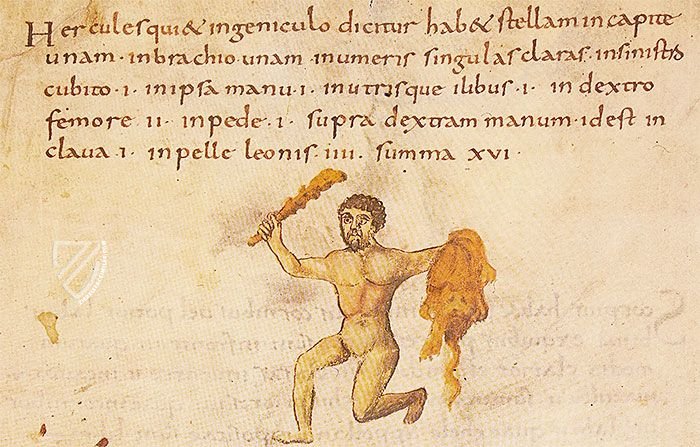
Metz Codex
Centaurus and Serpens
Holding a double-headed spear in one hand and a dead hare in the other, the constellation Centaurus, one of Ptolemy’s original 48, is presented in the upper register. He is the father of the race of centaurs, who are said to be wild, savage, and lustful. However, Centaurus is not to be confused with his more warlike cousin Sagittarius, who is distinguishable by his bow.
Adorned with a raven and an amphora of wine, the constellation Serpens is painted blue. This depiction is based on an ancient atlas that separates the constellations Serpens and Ophiuchus, which is unusual because of their mythological association: Ophiuchus represents the healer Asclepius, who learned how to revive dead people after witnessing the resurrection of a snake he killed.
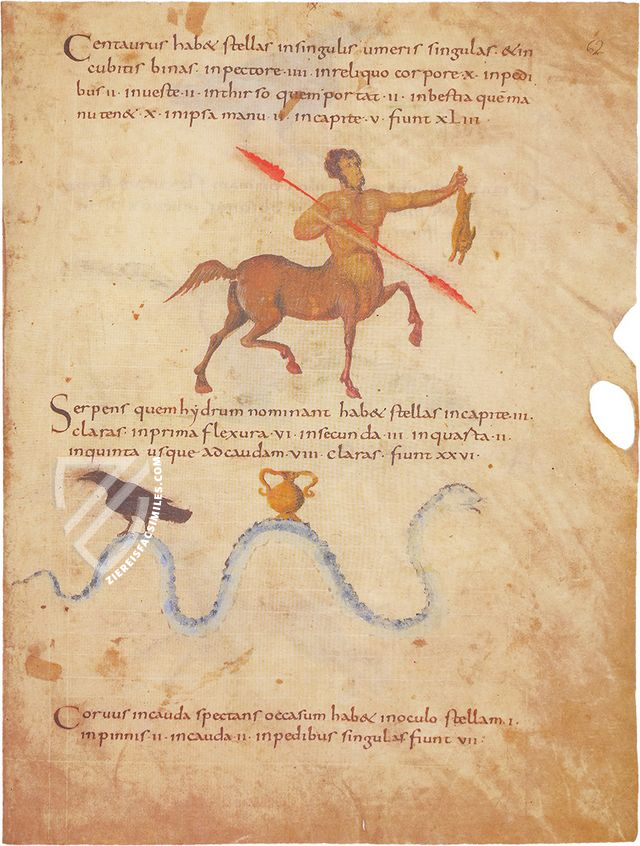
#1 Códice de Metz
Language: Spanish
(1,000€ - 3,000€)
- Treatises / Secular Books
- Apocalypses / Beatus
- Astronomy / Astrology
- Bestiaries
- Bibles / Gospels
- Chronicles / History / Law
- Geography / Maps
- Saints' Lives
- Islam / Oriental
- Judaism / Hebrew
- Single Leaf Collections
- Leonardo da Vinci
- Literature / Poetry
- Liturgical Manuscripts
- Medicine / Botany / Alchemy
- Music
- Mythology / Prophecies
- Psalters
- Other Religious Books
- Games / Hunting
- Private Devotion Books
- Other Genres
- Afghanistan
- Armenia
- Austria
- Belgium
- Belize
- Bosnia and Herzegovina
- China
- Colombia
- Costa Rica
- Croatia
- Cyprus
- Czech Republic
- Denmark
- Egypt
- El Salvador
- Ethiopia
- France
- Germany
- Greece
- Guatemala
- Honduras
- Hungary
- India
- Iran
- Iraq
- Israel
- Italy
- Japan
- Jordan
- Kazakhstan
- Kyrgyzstan
- Lebanon
- Liechtenstein
- Luxembourg
- Mexico
- Morocco
- Netherlands
- Palestine
- Panama
- Peru
- Poland
- Portugal
- Romania
- Russia
- Serbia
- Spain
- Sri Lanka
- Sweden
- Switzerland
- Syria
- Tajikistan
- Turkey
- Turkmenistan
- Ukraine
- United Kingdom
- United States
- Uzbekistan
- Vatican City
- A. Oosthoek, van Holkema & Warendorf
- Aboca Museum
- Ajuntament de Valencia
- Akademie Verlag
- Akademische Druck- u. Verlagsanstalt (ADEVA)
- Aldo Ausilio Editore - Bottega d’Erasmo
- Alecto Historical Editions
- Alkuin Verlag
- Almqvist & Wiksell
- Amilcare Pizzi
- Andreas & Andreas Verlagsbuchhandlung
- Archa 90
- Archiv Verlag
- Archivi Edizioni
- Arnold Verlag
- ARS
- Ars Magna
- ArtCodex
- AyN Ediciones
- Azimuth Editions
- Badenia Verlag
- Bärenreiter-Verlag
- Belser Verlag
- Belser Verlag / WK Wertkontor
- Benziger Verlag
- Bernardinum Wydawnictwo
- BiblioGemma
- Biblioteca Apostolica Vaticana (Vaticanstadt, Vaticanstadt)
- Bibliotheca Palatina Faksimile Verlag
- Bibliotheca Rara
- Boydell & Brewer
- Bramante Edizioni
- Bredius Genootschap
- Brepols Publishers
- British Library
- C. Weckesser
- Caixa Catalunya
- Canesi
- CAPSA, Ars Scriptoria
- Caratzas Brothers, Publishers
- Carus Verlag
- Casamassima Libri
- Centrum Cartographie Verlag GmbH
- Chavane Verlag
- Christian Brandstätter Verlag
- Circulo Cientifico
- Club Bibliófilo Versol
- Club du Livre
- CM Editores
- Collegium Graphicum
- Collezione Apocrifa Da Vinci
- Comissão Nacional para as Comemorações dos Descobrimentos Portugueses
- Coron Verlag
- Corvina
- CTHS
- D. S. Brewer
- Damon
- De Agostini/UTET
- De Nederlandsche Boekhandel
- De Schutter
- Deuschle & Stemmle
- Deutscher Verlag für Kunstwissenschaft
- DIAMM
- Droz
- E. Schreiber Graphische Kunstanstalten
- Ediciones Boreal
- Ediciones Grial
- Ediclube
- Edições Inapa
- Edilan
- Editalia
- Edition Deuschle
- Edition Georg Popp
- Edition Leipzig
- Edition Libri Illustri
- Editiones Reales Sitios S. L.
- Éditions de l'Oiseau Lyre
- Editions Medicina Rara
- Editorial Casariego
- Editorial Mintzoa
- Editrice Antenore
- Editrice Velar
- Edizioni Edison
- Egeria, S.L.
- Eikon Editores
- Electa
- Emery Walker Limited
- Enciclopèdia Catalana
- Eos-Verlag
- Ephesus Publishing
- Ernst Battenberg
- Eugrammia Press
- Extraordinary Editions
- Fackelverlag
- Facsimila Art & Edition
- Facsimile Editions Ltd.
- Facsimilia Art & Edition Ebert KG
- Faksimile Verlag
- Feuermann Verlag
- Folger Shakespeare Library
- Franco Cosimo Panini Editore
- Friedrich Wittig Verlag
- Fundación Hullera Vasco-Leonesa
- G. Braziller
- Gabriele Mazzotta Editore
- Gebr. Mann Verlag
- Gesellschaft für graphische Industrie
- Getty Research Institute
- Giovanni Domenico de Rossi
- Giunti Editore
- Graffiti
- Grafica European Center of Fine Arts
- Guido Pressler
- Guillermo Blazquez
- Gustav Kiepenheuer
- H. N. Abrams
- Harrassowitz
- Harvard University Press
- Helikon
- Hendrickson Publishers
- Henning Oppermann
- Herder Verlag
- Hes & De Graaf Publishers
- Hoepli
- Holbein-Verlag
- Houghton Library
- Hugo Schmidt Verlag
- Idion Verlag
- Il Bulino, edizioni d'arte
- ILte
- Imago
- Insel Verlag
- Insel-Verlag Anton Kippenberger
- Instituto de Estudios Altoaragoneses
- Instituto Nacional de Antropología e Historia
- Introligatornia Budnik Jerzy
- Istituto dell'Enciclopedia Italiana - Treccani
- Istituto Ellenico di Studi Bizantini e Postbizantini
- Istituto Geografico De Agostini
- Istituto Poligrafico e Zecca dello Stato
- Italarte Art Establishments
- Jan Thorbecke Verlag
- Johnson Reprint Corporation
- Josef Stocker
- Josef Stocker-Schmid
- Jugoslavija
- Karl W. Hiersemann
- Kasper Straube
- Kaydeda Ediciones
- Kindler Verlag / Coron Verlag
- Kodansha International Ltd.
- Konrad Kölbl Verlag
- Kurt Wolff Verlag
- La Liberia dello Stato
- La Linea Editrice
- La Meta Editore
- Lambert Schneider
- Landeskreditbank Baden-Württemberg
- Leo S. Olschki
- Les Incunables
- Liber Artis
- Library of Congress
- Libreria Musicale Italiana
- Lichtdruck
- Lito Immagine Editore
- Lumen Artis
- Lund Humphries
- M. Moleiro Editor
- Maison des Sciences de l'homme et de la société de Poitiers
- Manuscriptum
- Martinus Nijhoff
- Maruzen-Yushodo Co. Ltd.
- MASA
- Massada Publishers
- McGraw-Hill
- Metropolitan Museum of Art
- Militos
- Millennium Liber
- Müller & Schindler
- Nahar - Stavit
- Nahar and Steimatzky
- National Library of Wales
- Neri Pozza
- Nova Charta
- Oceanum Verlag
- Odeon
- Orbis Mediaevalis
- Orbis Pictus
- Österreichische Staatsdruckerei
- Oxford University Press
- Pageant Books
- Parzellers Buchverlag
- Patrimonio Ediciones
- Pattloch Verlag
- PIAF
- Pieper Verlag
- Plon-Nourrit et cie
- Poligrafiche Bolis
- Presses Universitaires de Strasbourg
- Prestel Verlag
- Princeton University Press
- Prisma Verlag
- Priuli & Verlucca, editori
- Pro Sport Verlag
- Propyläen Verlag
- Pytheas Books
- Quaternio Verlag Luzern
- Reales Sitios
- Recht-Verlag
- Reichert Verlag
- Reichsdruckerei
- Reprint Verlag
- Riehn & Reusch
- Roberto Vattori Editore
- Rosenkilde and Bagger
- Roxburghe Club
- Salerno Editrice
- Saltellus Press
- Sandoz
- Sarajevo Svjetlost
- Schöck ArtPrint Kft.
- Schulsinger Brothers
- Scolar Press
- Scrinium
- Scripta Maneant
- Scriptorium
- Shazar
- Siloé, arte y bibliofilia
- SISMEL - Edizioni del Galluzzo
- Sociedad Mexicana de Antropología
- Société des Bibliophiles & Iconophiles de Belgique
- Soncin Publishing
- Sorli Ediciones
- Stainer and Bell
- Studer
- Styria Verlag
- Sumptibus Pragopress
- Szegedi Tudomànyegyetem
- Taberna Libraria
- Tarshish Books
- Taschen
- Tempus Libri
- Testimonio Compañía Editorial
- Thames and Hudson
- The Clear Vue Publishing Partnership Limited
- The Facsimile Codex
- The Folio Society
- The Marquess of Normanby
- The Richard III and Yorkist History Trust
- Tip.Le.Co
- TouchArt
- TREC Publishing House
- TRI Publishing Co.
- Trident Editore
- Tuliba Collection
- Typis Regiae Officinae Polygraphicae
- Union Verlag Berlin
- Universidad de Granada
- University of California Press
- University of Chicago Press
- Urs Graf
- Vallecchi
- Van Wijnen
- VCH, Acta Humaniora
- VDI Verlag
- VEB Deutscher Verlag für Musik
- Verlag Anton Pustet / Andreas Verlag
- Verlag Bibliophile Drucke Josef Stocker
- Verlag der Münchner Drucke
- Verlag für Regionalgeschichte
- Verlag Styria
- Vicent Garcia Editores
- W. Turnowski Ltd.
- W. Turnowsky
- Waanders Printers
- Wiener Mechitharisten-Congregation (Wien, Österreich)
- Wissenschaftliche Buchgesellschaft
- Wissenschaftliche Verlagsgesellschaft
- Wydawnictwo Dolnoslaskie
- Xuntanza Editorial
- Zakład Narodowy
- Zollikofer AG

